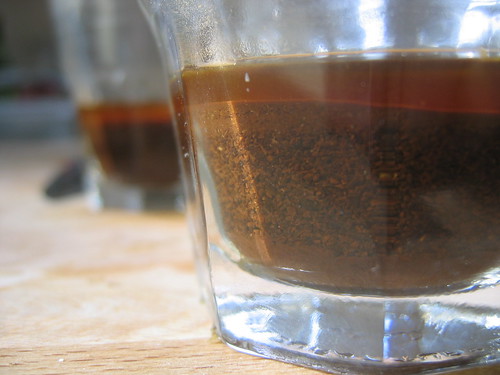We here at barismo decided to put on a cupping event to explore various offerings from premiere roasters across the country. The event will be hosted at Simon's Coffee Shop in Cambridge and will be held on the evening of April 21st. Seating is limited, so if you're interested please contact me at events@barismo.com for further details.
Tuesday, March 27, 2007
Upcoming Event: An Introduction to Coffee Cupping
We here at barismo decided to put on a cupping event to explore various offerings from premiere roasters across the country. The event will be hosted at Simon's Coffee Shop in Cambridge and will be held on the evening of April 21st. Seating is limited, so if you're interested please contact me at events@barismo.com for further details.
Labels:
events
Sunday, March 25, 2007
Don't blame the Barista!
The smell of rancid burnt coffee, the shot that pulls in 15 seconds... but it's not the barista who is really at fault here,is it? Sure it's easy to blame the person behind the counter for your bad cup of coffee but let's be realistic for a moment and take the long view.
When we look at all the quality inputs that go into a coffee from the seed to cup, there are a lot of points in the line that must be accounted for.
Yes, accountability is the key to production of any good product.
Pre-harvest, the terroir of the land and all climate inputs to the coffee are critical. Ideal rainfall, keeping away/treating pests and disease, and adequate shade are only a few of many issues the farmer faces in getting the crop to harvest. Once at harvest, care must be taken to pick the ripest cherries without damaging the tree and it's possible future growth. This means multiple passes over the harvest to get the ripest harvest possible. This is all based on if the weather permits.
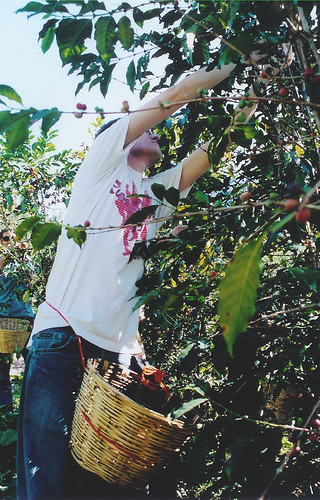
Assuming the crop is turning in a good harvest, the processing must be exceptional to clear away as many defects as possible. Under ripes, bug bitten, and all sorts of undesirables must be sorted out in either the milling phase, the processing method itself, or by hand.
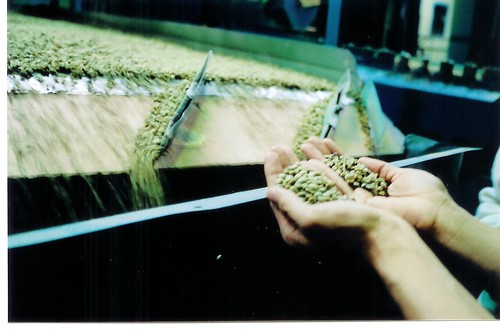
Now once this goes to market, the green buyer must find this pristine lot among many by identifying it with only a small sample to go on. Assuming the green buyer does identify the lot and arrange it's purchase, the lot can still be contaminated, age or otherwise change from the time the sample was taken to the time it arrives often months later.
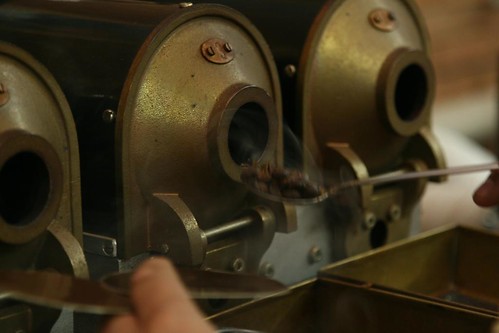
Photo Courtesy of Jason Silberschlag
Once the roaster has the bean in their hands, they must begin identifying an ideal roast profile and begin to reproduce it consistently. If the roast is not somewhat consistent, it will not be easy to produce a consistent product in the cafe. The roaster must then deal with logistics and packaging to get the correct coffees in the correct bags and to the correct people.
This is something almost every business must deal with and mis-labeling bags or inaccurate shipments is an accountability problem in the system, not necessarily a coffee specific issue.
The next phase is the cafe owners/management who must provide adequate equipment which must be cleaned, serviced, and maintained well for the end product to resemble what the roaster is providing. I have visited very few cafes which simply have grinders that are up to date where the burrs are changed regularly much less a knowledge of the temperature of the brew, so this presents one of the biggest problems in production.
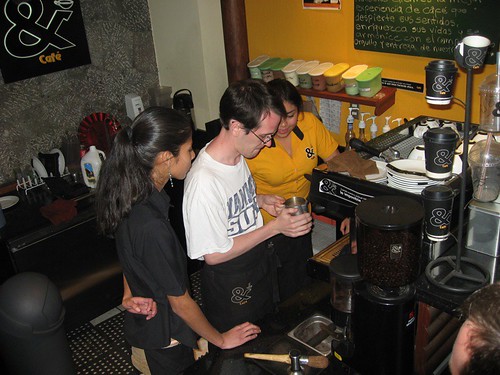
Photo Courtesy of Jorg and Corinna Scott
This is an issue where the cafe owner/management must work with knowledge often provided by the roaster to train staff and understand equipment maintenance and even adjust technique/parameters to get the most from the coffees. This is strictly an opinion, but great cafes are built on knowledge and one of the few legitimate sources of that knowledge and training should be the roaster. This is not often the case as many roasters have a fear or simply appear to not want to stir up trouble by suggesting improvements. This often shows up as a personnel issue where knowledgeable people with good communication skills are needed to get cafe owners on board with a quality program.
At the end of the line is the Barista. A low pay individual who is often left to their own devices with minimal training. Sadly, they are often left to the burden of selling a product they may not be proud to sell. To change this though, they must overcome management or push for changes when resistance may lie not only in management and with coworkers but at the Roasterie as well. A bit too much to ask from a Barista.
When you look at the bigger picture, it's hard to blame farmers who are simply responding to whatever we demand. It's also hard to focus simply on the Barista and put the entire weight of the process on their shoulders.
When you have a complaint about your coffee, consider leveling it at management or even better, call the roaster and discuss the account. Rather than focusing on the individual, we should focus on the organizations. Bringing attention to the company will create a need for training or change. While a barista is in no position to respond, the company can.
On the other hand, you could always look for another cup at another store in the future until you find a better coffee and vote with your wallet. The simple fact that we don't demand better or make our voice heard is part of the reason a good cup is hard to find.
When you do find a good Barista, tell the management and yes, please leave them a tip because good Barista are a good thing.
When we look at all the quality inputs that go into a coffee from the seed to cup, there are a lot of points in the line that must be accounted for.
Yes, accountability is the key to production of any good product.
Pre-harvest, the terroir of the land and all climate inputs to the coffee are critical. Ideal rainfall, keeping away/treating pests and disease, and adequate shade are only a few of many issues the farmer faces in getting the crop to harvest. Once at harvest, care must be taken to pick the ripest cherries without damaging the tree and it's possible future growth. This means multiple passes over the harvest to get the ripest harvest possible. This is all based on if the weather permits.

Assuming the crop is turning in a good harvest, the processing must be exceptional to clear away as many defects as possible. Under ripes, bug bitten, and all sorts of undesirables must be sorted out in either the milling phase, the processing method itself, or by hand.

Now once this goes to market, the green buyer must find this pristine lot among many by identifying it with only a small sample to go on. Assuming the green buyer does identify the lot and arrange it's purchase, the lot can still be contaminated, age or otherwise change from the time the sample was taken to the time it arrives often months later.

Photo Courtesy of Jason Silberschlag
Once the roaster has the bean in their hands, they must begin identifying an ideal roast profile and begin to reproduce it consistently. If the roast is not somewhat consistent, it will not be easy to produce a consistent product in the cafe. The roaster must then deal with logistics and packaging to get the correct coffees in the correct bags and to the correct people.
This is something almost every business must deal with and mis-labeling bags or inaccurate shipments is an accountability problem in the system, not necessarily a coffee specific issue.
The next phase is the cafe owners/management who must provide adequate equipment which must be cleaned, serviced, and maintained well for the end product to resemble what the roaster is providing. I have visited very few cafes which simply have grinders that are up to date where the burrs are changed regularly much less a knowledge of the temperature of the brew, so this presents one of the biggest problems in production.

Photo Courtesy of Jorg and Corinna Scott
This is an issue where the cafe owner/management must work with knowledge often provided by the roaster to train staff and understand equipment maintenance and even adjust technique/parameters to get the most from the coffees. This is strictly an opinion, but great cafes are built on knowledge and one of the few legitimate sources of that knowledge and training should be the roaster. This is not often the case as many roasters have a fear or simply appear to not want to stir up trouble by suggesting improvements. This often shows up as a personnel issue where knowledgeable people with good communication skills are needed to get cafe owners on board with a quality program.
At the end of the line is the Barista. A low pay individual who is often left to their own devices with minimal training. Sadly, they are often left to the burden of selling a product they may not be proud to sell. To change this though, they must overcome management or push for changes when resistance may lie not only in management and with coworkers but at the Roasterie as well. A bit too much to ask from a Barista.
When you look at the bigger picture, it's hard to blame farmers who are simply responding to whatever we demand. It's also hard to focus simply on the Barista and put the entire weight of the process on their shoulders.
When you have a complaint about your coffee, consider leveling it at management or even better, call the roaster and discuss the account. Rather than focusing on the individual, we should focus on the organizations. Bringing attention to the company will create a need for training or change. While a barista is in no position to respond, the company can.
On the other hand, you could always look for another cup at another store in the future until you find a better coffee and vote with your wallet. The simple fact that we don't demand better or make our voice heard is part of the reason a good cup is hard to find.
When you do find a good Barista, tell the management and yes, please leave them a tip because good Barista are a good thing.
Saturday, March 24, 2007
Tipping the roast
Tipping and scorching are roasting errors which lead to an uneven roast. You can read more about this topic in this brilliant article by Willem Boot.
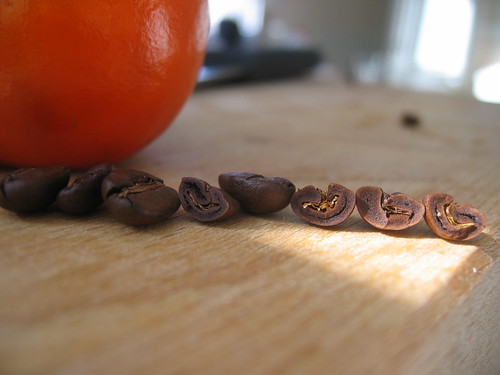
Photography by Ben Kaminsky
A friend once addressed me saying that I surround myself with many people who don't scorch or tip and I began to see that as the norm. I didn't disagree but the truth is we have dealt with this particular subject for a long time to the point it is affectionately called the New Flava Roast or the 'single bean melange' in mockery.
The particular flavors that come from this are not enjoyable in the least. You have vinegar and ash in the same cup where I can honestly say it would take an odd palate to put wonderful descriptors to this one.

Photography by Ben Kaminsky
Interior scorching is identified by this layered coloration. You can have defined unevenness which will lead to a fuzzy taste profile and a murky cup. There are no layers or clarity in the cup and no distinct flavors. Often unpleasant and if you didn't take the time to crack open a bean and examine the interior, the outer coloration would look normal.
Pay attention to your roasts people!

Photography by Ben Kaminsky
A friend once addressed me saying that I surround myself with many people who don't scorch or tip and I began to see that as the norm. I didn't disagree but the truth is we have dealt with this particular subject for a long time to the point it is affectionately called the New Flava Roast or the 'single bean melange' in mockery.
The particular flavors that come from this are not enjoyable in the least. You have vinegar and ash in the same cup where I can honestly say it would take an odd palate to put wonderful descriptors to this one.

Photography by Ben Kaminsky
Interior scorching is identified by this layered coloration. You can have defined unevenness which will lead to a fuzzy taste profile and a murky cup. There are no layers or clarity in the cup and no distinct flavors. Often unpleasant and if you didn't take the time to crack open a bean and examine the interior, the outer coloration would look normal.
Pay attention to your roasts people!
Tuesday, March 20, 2007
'Lemony' Espresso

I had another shot of a 'lemony' espresso this morning. One I would normally refuse but it was free and I felt I could not refuse since it was my opinion that was sought. It was not painful, nor was it comparable in sweetness to our last espresso venture. In fact, it was kinda boring or you could say clean in the 'I don't mean' way. Not much aroma, very little creaminess and little viscosity. It was like a little lemon curd pastry in it's singular flavor component. It is not that I do not like a little lemon citrus in my espresso, it's just that I like somethng creamy and thicker for espresso. Once upon a time, Ben and I may have said this was a unique espresso but times have changed... a lot.
A nice Yirgacheffe with beautiful aromatics and a hint of lemon is nice. A Kenya, a Guat, or a Colombia with some lemon would be interesting. I love a good fruit character in a coffee but this shot was none of these.
It is not that a Brazil cannot be lemon but the question is should a classic washed Brazil in espresso be all lemon? OR maybe the question is, could I sell something like this with confidence and conviction?
Brazils can be boring but honestly, they make a much better base than your garden variety earthy spice characters often used as a base in espresso. When I think of Brazil though, I think vanilla, sarsaparilla, nut, cocoa, caramel, molasses... sure, but lemon, I am not sold on that. It's like trying to pull fruit out of something that isn't, for lack of a better term, fruity.
I don't know if lemon is really a big issue for me in an espresso I don't drink and would not serve but maybe that's not my point in writing today. I realized that this drink sparked a conversation.
You have to have perspective.
The best thing I ever did was consistently serve multiple espresso and varied roaster's coffees in one shop. When you only see one roaster's perspective, you lose your perspective. If all you ever really taste are your own coffees from one source, you will not have a greater understanding of other people's styles and the realm of possibilities that exist beyond what you are currently serving in a cafe. As a Barista, a shop owner, a consumer, and also at the roasterie, trying various styles leads to growth in palate and appreciation of what coffee can be.
I had a long debate about this with friends (Corinna and Jorg) in Guatemala. The greatest single thing you can do for yourself is to try everything and don't buy into the hype about anything. For all the Gurus and supposed Masters, there are a dozen others who scoot by under the radar doing amazing things without flashy egos or lengthy diatribes on why they are the best.
Sometimes, it's the guys who aren't selling themselves to their peers who are doing great things in their own shops. If I hadn't been guesting coffees, I never would have run across Andrew Barnett, Miguel Meza, or a whole other group of roasters out there doing respectable work. Heck, we may have even thumbed our nose at other great roasters simply because they didn't agree with what our current roaster is doing if it weren't for our guesting program.
Some podcaster once offered that a roaster is like the religion you choose, I would offer that roasters are like chefs and there are many to choose from with lots of perspectives on interpretation of the same ingredients. Sometimes, you can mix or match to what you perceive as their strong points, other times you let them lead you to a unique experience.
Coffee is an evolution and if you lock in too hard to one philosophy, there you will be and no further.
Point is, whether you were hooked into coffee by a chocolate ristretto or a lemony lungo, take the time to see what else is out there and give it a chance with an open mind and a curious palate. Don't listen to the pundits and try everything for youself because there are no standards and there is a unique new taste out there around every corner.
Friday, March 09, 2007
The Green Storage Project...
Aaron, Eddie and I had a long set of email discussions leading to what we are calling the green coffee storage project. It is a collaboration among people we respect to effectively explore what happens to coffee in normal storage and estimate what options are available to a roaster on a budget to keep green at optimal quality until the next crop and possibly beyond.
The key is not to break new ground but to establish data and facts in a project that is repeatable for most any home user or small budget roaster. A lot of opinions have been offered and we felt it was time to do the research instead. This project is about exploration and transparency rather than obtaining proprietary knowledge.
Goal: To determine the necessity for better green transport and packaging standards. To evaluate and graph green age. To summarize the results and then conclude how to slow or prevent coffee flavor/aroma deterioration due to green age.
To determine measures to preserve new crop taste through the entire usage of a coffee.
Key materials:
-Green Coffee(Finca Vista Hermosa Michicoy)
-Vacuum packing and freezing materials available on a reasonable budget
Key Test Components:
Set 1: Coffee stored traditionally at a warehouse; shipped from Guatemala via standard means 2-3 months from harvest.
Set 2: Vacuum sealed coffees stored by the roaster; expedited from Guatemala weeks after harvest/milling.
Set 3: Vacuum sealed coffees frozen at 0-20C by the roaster; expedited from Guatemala weeks after harvest/milling.
The Setup:
Four groups will each have sets of samples provided to them.
At intervals over a two year period, the samples of regular green, vacuum sealed and frozen will be opened and roasted against each other. It will be up to each group to note or identify any changes or differences in each coffee that they observe and share these notes with the other groups.
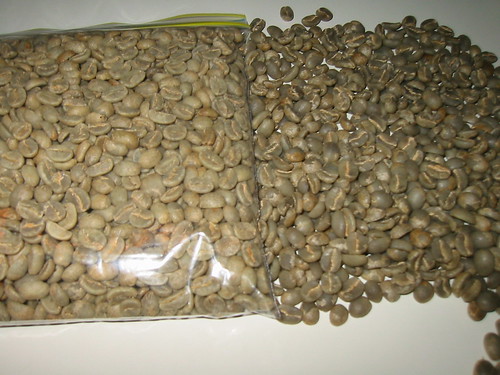
It was necessary to find respectable roasters who could look at the project from a pure quality standpoint and lend valuable notes on perceivable changes(if any) that existed in each set.
We appreciate Steve and Miguel joining Aaron and our crew in this venture. I hope they gain from this setup or at least enjoy the green in the process. I appreciate Edwin being so open to the idea and for his willingness to evaluate anything in the name of research or education. The goal is not to validate but simply for better understanding of green storage and the only expectation I have is that we will all come away with something from this project.
The project begins in the next few months and we at Barismo will be documenting bits and pieces of our personal experience when it is relevant.

The key is not to break new ground but to establish data and facts in a project that is repeatable for most any home user or small budget roaster. A lot of opinions have been offered and we felt it was time to do the research instead. This project is about exploration and transparency rather than obtaining proprietary knowledge.
Goal: To determine the necessity for better green transport and packaging standards. To evaluate and graph green age. To summarize the results and then conclude how to slow or prevent coffee flavor/aroma deterioration due to green age.
To determine measures to preserve new crop taste through the entire usage of a coffee.
Key materials:
-Green Coffee(Finca Vista Hermosa Michicoy)
-Vacuum packing and freezing materials available on a reasonable budget
Key Test Components:
Set 1: Coffee stored traditionally at a warehouse; shipped from Guatemala via standard means 2-3 months from harvest.
Set 2: Vacuum sealed coffees stored by the roaster; expedited from Guatemala weeks after harvest/milling.
Set 3: Vacuum sealed coffees frozen at 0-20C by the roaster; expedited from Guatemala weeks after harvest/milling.
The Setup:
Four groups will each have sets of samples provided to them.
At intervals over a two year period, the samples of regular green, vacuum sealed and frozen will be opened and roasted against each other. It will be up to each group to note or identify any changes or differences in each coffee that they observe and share these notes with the other groups.

It was necessary to find respectable roasters who could look at the project from a pure quality standpoint and lend valuable notes on perceivable changes(if any) that existed in each set.
We appreciate Steve and Miguel joining Aaron and our crew in this venture. I hope they gain from this setup or at least enjoy the green in the process. I appreciate Edwin being so open to the idea and for his willingness to evaluate anything in the name of research or education. The goal is not to validate but simply for better understanding of green storage and the only expectation I have is that we will all come away with something from this project.
The project begins in the next few months and we at Barismo will be documenting bits and pieces of our personal experience when it is relevant.

Wednesday, March 07, 2007
So that's what zero defect coffee tastes like...
We got a shipment of coffees from Mr. Simon Hsieh who is a roaster going by the moniker of 4-Arts zero-defects coffees in Taiwan. It's not just a fancy name when he says zero defects. Simon sorts his coffee personally to achieve a promise of zero cup defects in all of his roasts.
So you may be thinking about what zero defects means. There are obvious defects as pictured here via coffeeresearch.org. What we know is that Simon removes any obvious defects found but also sorts the coffee to a more even size and color consistency. This means cleaning a coffee up the hard way with some manual labor. When Simon says zero defects, he's not joking.
Simon can turn a bean up to five times sorting pre-roast and then once more post-roast to identify visible defects or what he determines as off beans that may ruin a cup. This is a very intense and dedicated way to get a better cup. As all searches for a better cup go, it's never easy. Sorting at the roasterie is something that would be cost prohibitive to almost everyone in our American industry beyond the fanatical home roaster. It is the home roaster who has little access to good green that this process is intriguing though because it appears that a little extra sorting could potentially clean up an otherwise funky coffee.
It is a very unique and somewhat extreme approach that at first you may be inclined to question. Rightfully so, but you should give it a go and see what he is looking at and attempt to contemplate the logic behind it a bit. There are two ways to do this. One, you have Simon do this for you and pay him well, plus shipping costs to achieve this. Two, you sit down and sort out some home roast. I suggest you do a high grade coffee like a CoE and compare it to a C-Grade Sumatra. Measure the throw away percent on both and report back to us on the results should you choose to accept this mission...

Image Courtesy of Jason Silberschlag
At first glance it would be easy to throw this out the window and say it's a bit crazy to do this. I think too many people in the industry are easily willing to ignore what others are doing without trying to understand the reasoning behind their choices. The logic may be flawed or it may be correct. Truth is, you don't know what the results are until you take the time and do the experiment for yourself.
Simon's exercise in sorting has a lesson to teach us. Sorting makes a difference. In fact, the simple exercise of sitting down and sorting a few rows of coffee will give you new perspective on exactly what defects are and how one bean can easily ruin a cup. Sort out the defects, roast them and cup them next to the sorted cup. You will then better understand what is causing each cup's components and then the mushrooms may not be so charming any more.
It's not a clean coffee rant today though. It's a question of what is in my cup and why does it taste the way it does? Can you identify the good as well as the bad? Equating input to output and identifying the causes of flavors in the cups is harder than you think.
Doing sorting is like an educational adventure. After a few episodes, you will appreciate the great lots which require less than 20% rejection rates while you will fall apart at the purchase of a green which has a 50%+ rejection rate. Something to think about next time you try any coffee.
As for Simon's coffees, we sampled a Nicaragua CoE#14, 20% CoE espresso Blend, and Idido Misty Valley Grade 1. That last one may strike you as odd for our crew but we have tried a few versions of this coffee in the US (though not Grade 1), so it was to be a comparison cup. It was a strange cup. Simon describes it as orange juice and that's pretty accurate. Not my personal choice of coffees though as I still cling to dreams about an aromatic washed Yirgacheffe that may someday resurface when our fermented Ethiopian naturals fascination ends...

All that aside, Simon achieved something I had not tasted before, previous versions of Misty Valley bordered on rank and pungent, almost rotten fruits at times ready to kick you in the face with their untamed intensity. This offering was balanced and persisted like a heavy perfume that weighed down my nostrils leaving a strong aroma and thick sweetness. It did not really resemble what we had tasted in our cupping sessions or varied trips to famous coffee houses. Shocking indeed.
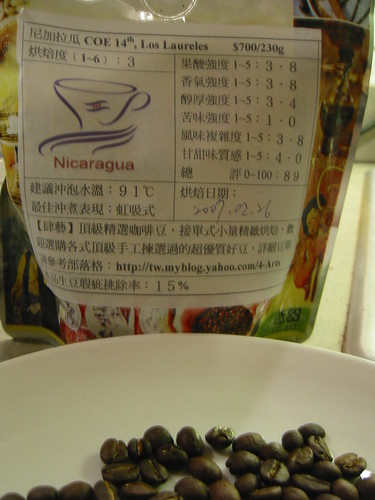
The Nicaragua was a dark sugar cup, a balanced roast which came out well in the vac pot, being my pick of his offerings. The 15% at the bottom of the label is Simon's rejection rate for the Nicaragua.
The 20% CoE espresso blend was nice and very clean but I have such bias against earthiness in coffees, I would love to replace that Java Jampit component with something else. It was however, on the level with Stumptown's hairbender in that it was ripe and had good fruit in the cup and a defined sweetness. It was brewed in the low 190'sF and pulled very ristretto making for what was a lingering sweet cup with a winey aftertaste and lacking in pronounced bitterness. Again, it was balanced but complex with a heavy candied sweetness which seems to be Simon's signature style.

Go ahead and add meticulous sorting to our wish list along with fresher green and high grown coffees.
So you may be thinking about what zero defects means. There are obvious defects as pictured here via coffeeresearch.org. What we know is that Simon removes any obvious defects found but also sorts the coffee to a more even size and color consistency. This means cleaning a coffee up the hard way with some manual labor. When Simon says zero defects, he's not joking.
Simon can turn a bean up to five times sorting pre-roast and then once more post-roast to identify visible defects or what he determines as off beans that may ruin a cup. This is a very intense and dedicated way to get a better cup. As all searches for a better cup go, it's never easy. Sorting at the roasterie is something that would be cost prohibitive to almost everyone in our American industry beyond the fanatical home roaster. It is the home roaster who has little access to good green that this process is intriguing though because it appears that a little extra sorting could potentially clean up an otherwise funky coffee.
It is a very unique and somewhat extreme approach that at first you may be inclined to question. Rightfully so, but you should give it a go and see what he is looking at and attempt to contemplate the logic behind it a bit. There are two ways to do this. One, you have Simon do this for you and pay him well, plus shipping costs to achieve this. Two, you sit down and sort out some home roast. I suggest you do a high grade coffee like a CoE and compare it to a C-Grade Sumatra. Measure the throw away percent on both and report back to us on the results should you choose to accept this mission...

Image Courtesy of Jason Silberschlag
At first glance it would be easy to throw this out the window and say it's a bit crazy to do this. I think too many people in the industry are easily willing to ignore what others are doing without trying to understand the reasoning behind their choices. The logic may be flawed or it may be correct. Truth is, you don't know what the results are until you take the time and do the experiment for yourself.
Simon's exercise in sorting has a lesson to teach us. Sorting makes a difference. In fact, the simple exercise of sitting down and sorting a few rows of coffee will give you new perspective on exactly what defects are and how one bean can easily ruin a cup. Sort out the defects, roast them and cup them next to the sorted cup. You will then better understand what is causing each cup's components and then the mushrooms may not be so charming any more.
It's not a clean coffee rant today though. It's a question of what is in my cup and why does it taste the way it does? Can you identify the good as well as the bad? Equating input to output and identifying the causes of flavors in the cups is harder than you think.
Doing sorting is like an educational adventure. After a few episodes, you will appreciate the great lots which require less than 20% rejection rates while you will fall apart at the purchase of a green which has a 50%+ rejection rate. Something to think about next time you try any coffee.
As for Simon's coffees, we sampled a Nicaragua CoE#14, 20% CoE espresso Blend, and Idido Misty Valley Grade 1. That last one may strike you as odd for our crew but we have tried a few versions of this coffee in the US (though not Grade 1), so it was to be a comparison cup. It was a strange cup. Simon describes it as orange juice and that's pretty accurate. Not my personal choice of coffees though as I still cling to dreams about an aromatic washed Yirgacheffe that may someday resurface when our fermented Ethiopian naturals fascination ends...

All that aside, Simon achieved something I had not tasted before, previous versions of Misty Valley bordered on rank and pungent, almost rotten fruits at times ready to kick you in the face with their untamed intensity. This offering was balanced and persisted like a heavy perfume that weighed down my nostrils leaving a strong aroma and thick sweetness. It did not really resemble what we had tasted in our cupping sessions or varied trips to famous coffee houses. Shocking indeed.

The Nicaragua was a dark sugar cup, a balanced roast which came out well in the vac pot, being my pick of his offerings. The 15% at the bottom of the label is Simon's rejection rate for the Nicaragua.
The 20% CoE espresso blend was nice and very clean but I have such bias against earthiness in coffees, I would love to replace that Java Jampit component with something else. It was however, on the level with Stumptown's hairbender in that it was ripe and had good fruit in the cup and a defined sweetness. It was brewed in the low 190'sF and pulled very ristretto making for what was a lingering sweet cup with a winey aftertaste and lacking in pronounced bitterness. Again, it was balanced but complex with a heavy candied sweetness which seems to be Simon's signature style.

Go ahead and add meticulous sorting to our wish list along with fresher green and high grown coffees.
Tuesday, March 06, 2007
AeroPress Revisited
Long time readers of the blog (if such things exist) might recalled that we've reviewed the famed AeroPress way back then.
Using it in the stock configuration and mimicking brewing parameters of a clover (time, temperature, grind dosage and coarseness), the aeropress produces a cup that is cleaner, yet inferior to a french press cup.
The problem has to do with uneven extraction due to seep thru that occurred as soon as you pour water thru the grinds. Using it in the inverted manner, the cup improves a bit as it allowed the coffee to extract more evenly at desirable temperature.
Despite improvements with the inverted method, the resulting cup is still inferior to a regular french press cup in both aroma and flavor; the stock paper filter, while capable of producing a very clean up, simply absorbed too much of the oil and aromatics.

Photo Courtesy of Gabe Rodriguez
Several weeks passed and the buzz with AeroPress continued on CG. I noticed a new development with the inverted method. The stock paper filter is replaced with a polyester felt round that allows much of the aromatics and the oils to pass thru. A couple of email exchanges with Scott yielded a generous offer of samples of these poly-felt rounds for me to play with.
Following Scott's instructions, I was able to produce cups that retained the flavor and aroma, while being much cleaner than the french press. Using brewing parameters similar to a clover brew, the cup comes surprisingly close according to Jaime, and is sweeter than the french press cups. We concluded that, while being a bit clumsy and messy, this configuration (inverted + poly-felt) produces a satisfying cup that is good enough of a reason to keep this device in our array of coffee brewing apparatus.
However, after my recent visit to Taiwan, things changed a bit.
A vac pot is what I use, almost exclusively, for "brew coffee" now. The vac pot has all the advantages of my coffee brewing devices: near constant brewing temperatures, adjustable brew temperature and time, as well as a cake filtration that produces a very clean cup.
Upon learning the proper method and brewing parameters of the vac pot, I was able to produce cups that are the cleanest, most complex, and most aromatic among the three brewing methods. It also produces cups that have a long and lingering tail that stays in your mouth well after consumption. The brewing/clean-up is not much worse than the inverted poly-felt aeropress and it takes less than 5 min from grind to clean-up. The total cost of the setup is also comparable to the AeroPress.
Unfortunately, I am not aware of any US retailer selling the 2 cup version of the Hario Vac Pot. The larger vac pot units are not very desirable as you need to brew it at capacity in order to have a proper extraction. In fact, I had a 5 cup unit that I ended up gifting away due to that (there is no way in hell I can drink that much coffee without getting caffeine sickness).
Using it in the stock configuration and mimicking brewing parameters of a clover (time, temperature, grind dosage and coarseness), the aeropress produces a cup that is cleaner, yet inferior to a french press cup.
The problem has to do with uneven extraction due to seep thru that occurred as soon as you pour water thru the grinds. Using it in the inverted manner, the cup improves a bit as it allowed the coffee to extract more evenly at desirable temperature.
Despite improvements with the inverted method, the resulting cup is still inferior to a regular french press cup in both aroma and flavor; the stock paper filter, while capable of producing a very clean up, simply absorbed too much of the oil and aromatics.

Photo Courtesy of Gabe Rodriguez
Several weeks passed and the buzz with AeroPress continued on CG. I noticed a new development with the inverted method. The stock paper filter is replaced with a polyester felt round that allows much of the aromatics and the oils to pass thru. A couple of email exchanges with Scott yielded a generous offer of samples of these poly-felt rounds for me to play with.
Following Scott's instructions, I was able to produce cups that retained the flavor and aroma, while being much cleaner than the french press. Using brewing parameters similar to a clover brew, the cup comes surprisingly close according to Jaime, and is sweeter than the french press cups. We concluded that, while being a bit clumsy and messy, this configuration (inverted + poly-felt) produces a satisfying cup that is good enough of a reason to keep this device in our array of coffee brewing apparatus.
However, after my recent visit to Taiwan, things changed a bit.
A vac pot is what I use, almost exclusively, for "brew coffee" now. The vac pot has all the advantages of my coffee brewing devices: near constant brewing temperatures, adjustable brew temperature and time, as well as a cake filtration that produces a very clean cup.
Upon learning the proper method and brewing parameters of the vac pot, I was able to produce cups that are the cleanest, most complex, and most aromatic among the three brewing methods. It also produces cups that have a long and lingering tail that stays in your mouth well after consumption. The brewing/clean-up is not much worse than the inverted poly-felt aeropress and it takes less than 5 min from grind to clean-up. The total cost of the setup is also comparable to the AeroPress.
Unfortunately, I am not aware of any US retailer selling the 2 cup version of the Hario Vac Pot. The larger vac pot units are not very desirable as you need to brew it at capacity in order to have a proper extraction. In fact, I had a 5 cup unit that I ended up gifting away due to that (there is no way in hell I can drink that much coffee without getting caffeine sickness).
Labels:
aeropress,
clover,
drip methods,
gear,
vac pot
Monday, March 05, 2007
New Cultivar Taiwan No. 18
To most of the tea world, Taiwan is known for it's wonderful Paochongs and Bai Hao Oolongs and for good reasons. Focus on these styles of tea has brought the world some of the best and most interesting teas. While most of the tea produced in Taiwan has been Oolong, The Tea Research and Extension Station located in the hills surrounding Sun Moon Lake has also focused on the development and production of black tea. Producing 11 of the 20 new cultivars since 1969 suited for black tea, a peak was reached with the development of cultivar number 18. Released officially in 1999 this tea is basically unknown outside of Taiwan. Crossing an assam strain from Burma and a local wild tea strain, the Research and Extension station has created one of the most truly unique and quality black teas in the world.
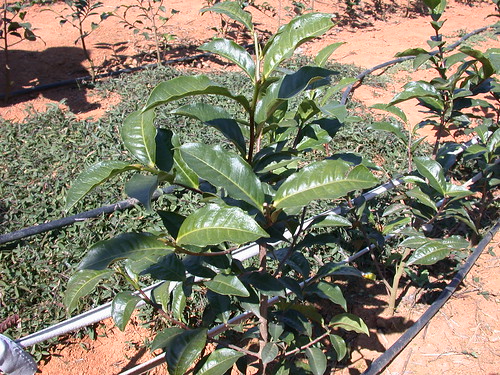
One of the things that makes this tea unique is the fact that it is a cross between an Assam strain and a Taiwan wild strain. The Taiwan wild variety of tea is most similar to the China plant but classified as a separate variety from the two main varieties, Assam and China plants, because it is really a different plant. Number 18 is a strong bush with fairly thick leathery leaves and a purplish shine. It is of much lower yield than the other cultivars created in Taiwan for black tea and has large buds but no pekoe growths. The survival rate is 87.6%, it has strong heat resistance and has a fairly strong resistance to disease, making this cultivar ideal to grow.
Of course, none of this would matter if the taste was not there. This tea is known for its mint and cinnamon qualities and these flavors were certainly present when we cupped it. Not only are those flavors present but we also got rose, molasses, honey and lemon verbena as well. This time when we cupped this tea, we initially did not share tasting notes. Ben C. brought this back from Taiwan and made all of us taste the tea separately and without telling us what it tasted like. Jaime initially got cinnamon and mint, when he and Ben and Hong cupped it. Hong added rose to the notes and then they decided to test the palates of Ben K, Judson and I. Ben, after a long day of espresso shot tasting and barista-ing, still came through with the same tasting notes. That is how powerful and defined this tea is.
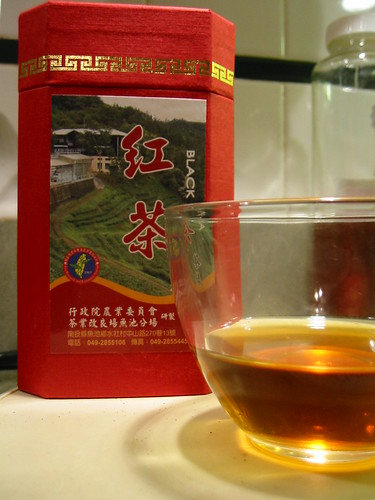
Originally when we cupped this tea, from a different batch/producer/farm that was sent from Taiwan, we were not that impressed. It is fairly generic with much more subtle notes and some off flavors. When Ben C. asked the Taiwan Research and Extension Station about this, they said that this was because of the inferior processing of the batch we had received. This just goes to show how important processing is in bringing out the flavor of the cultivar and the end result of the tea.
This is another in the line of many great steps towards the development of quality tea in Taiwan. The Taiwan Research and Extension station plans to further the development of both black tea and wild tea cultivars in the future. It takes them about 21 years to develop a cultivar to the point where it can be used in commercial production and from what I can see, this is time well spent. In the past, the black tea that Taiwan has produced was low quality and exported, and since 1999 one of the goals has been to promote it locally. Promotion for high quality exports of Taiwan no. 18 or Hong Yu (Red Jade) are also on the way.

One of the things that makes this tea unique is the fact that it is a cross between an Assam strain and a Taiwan wild strain. The Taiwan wild variety of tea is most similar to the China plant but classified as a separate variety from the two main varieties, Assam and China plants, because it is really a different plant. Number 18 is a strong bush with fairly thick leathery leaves and a purplish shine. It is of much lower yield than the other cultivars created in Taiwan for black tea and has large buds but no pekoe growths. The survival rate is 87.6%, it has strong heat resistance and has a fairly strong resistance to disease, making this cultivar ideal to grow.
Of course, none of this would matter if the taste was not there. This tea is known for its mint and cinnamon qualities and these flavors were certainly present when we cupped it. Not only are those flavors present but we also got rose, molasses, honey and lemon verbena as well. This time when we cupped this tea, we initially did not share tasting notes. Ben C. brought this back from Taiwan and made all of us taste the tea separately and without telling us what it tasted like. Jaime initially got cinnamon and mint, when he and Ben and Hong cupped it. Hong added rose to the notes and then they decided to test the palates of Ben K, Judson and I. Ben, after a long day of espresso shot tasting and barista-ing, still came through with the same tasting notes. That is how powerful and defined this tea is.

Originally when we cupped this tea, from a different batch/producer/farm that was sent from Taiwan, we were not that impressed. It is fairly generic with much more subtle notes and some off flavors. When Ben C. asked the Taiwan Research and Extension Station about this, they said that this was because of the inferior processing of the batch we had received. This just goes to show how important processing is in bringing out the flavor of the cultivar and the end result of the tea.
This is another in the line of many great steps towards the development of quality tea in Taiwan. The Taiwan Research and Extension station plans to further the development of both black tea and wild tea cultivars in the future. It takes them about 21 years to develop a cultivar to the point where it can be used in commercial production and from what I can see, this is time well spent. In the past, the black tea that Taiwan has produced was low quality and exported, and since 1999 one of the goals has been to promote it locally. Promotion for high quality exports of Taiwan no. 18 or Hong Yu (Red Jade) are also on the way.
Subscribe to:
Posts (Atom)

